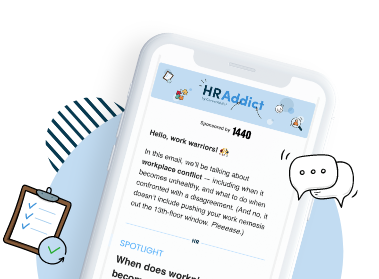We can probably safely assume that interpersonal conflict has existed for as long as humans have. But although it’s such a common and natural occurrence, not everyone knows how to navigate it effectively.
In the workplace especially, where people from all backgrounds come together on the daily, exchanging ideas and relying on one another, tension and quarrels become all the more likely.
In this article, we’ll look at how leaders can minimize the likelihood of conflict, what they can do when it does arise, and what happens when they fail to address it effectively.
What is conflict in the workplace?
Workplace conflict, also known as organizational conflict, refers to misunderstandings and disagreements that occur between different members of a team. Depending on the personalities of those involved, as well as the context they find themselves in, conflict can range from (more subtle) passive aggression to full-blown rows.
Types of workplace conflict
Bosses, managers and HR professionals across all industries have to be prepared to identify and deal with different types of conflict in the workplace. These are:
Intrapersonal conflict
Although this isn’t the first scenario that comes to mind when we think of workplace conflict, you may, as a leader, still have to help a member of your team deal with intrapersonal (or internal) conflict.
This may occur when an employee doesn’t agree with or has concerns about what they’re being asked to do, for example, leaving them stuck in a dilemma.
Interpersonal conflict
Interpersonal conflict refers to conflict that occurs between two or more individuals. It can arise due to unhealthy workplace competition, miscommunication, opposing opinions or values, or even a power struggle between colleagues.
Intragroup conflict
Intragroup conflict occurs internally within a team, between its various members. It can involve all individuals within the group or only some of them, and can typically arise when information is not passed on correctly or when one (or more) people fail to complete their work on time, slowing down everyone else or causing others to work more than is their fair share.
Intergroup conflict
Intergroup conflict is similar to intragroup conflict, except it happens between groups of individuals: one team “against” another — and sometimes it can involve more than two teams.
The causes of workplace conflicts
Unfortunately, workplace conflict is inevitable. Although it can happen due to a number of reasons, the most common culprits tend to be:
- Miscommunication
- Differing values
- Personality clashes
- Bullying or harassment
- Poor management/leadership
As for the final bullet point, poor leadership in the workplace can create a lot of problems for employees, which can increase the likelihood of conflict. Bad management can show itself in various ways, including:
- Unfair treatment of employees
- Unclear job roles and expectations
- Lack of training, support and resources
- Lack of equal opportunities
All these things can create a high-stress environment; and the more stressed, unsupported or wronged employees feel, the less likely they’ll be to employ their conflict resolution skills effectively.
The consequences of workplace conflict
If left unaddressed and unresolved, workplace conflict can turn a great work environment into an unhealthy one. This can have a domino effect: if two individuals keep arguing, for example, the people around them are also bound to lose their patience or become stressed over time. If intragroup or intergroup conflict occurs frequently, it can wear everyone down, impacting productivity.
This can increase absenteeism, as more people start to look for ways to get out of work or develop physical symptoms of stress. Presenteeism can also go up; employees may be present, but unable to perform their tasks optimally. Finally, workplace conflict can cause voluntary turnover to rise, which is very costly, like absenteeism and presenteeism.
Taking all this into account, it’s easy to see why taking the necessary steps to resolve conflicts quickly is of paramount importance.
How to spot conflict in the workplace
Organizational conflict can reveal itself in many ways, both in how people carry themselves and behave. Keeping an eye out for the following can be useful:
- Behavioral changes: When employees start to become avoidant or snappy, or give one-word responses, it can be a sign of stress due to conflict.
- Closed-off body language: Non-verbal communication can give you a lot of insight into your employees’ wellbeing (or lack thereof).
- High absenteeism: Unresolved or frequent conflict can cause employees to want to avoid the office, or even become unwell and unable to turn up.
- Decrease in productivity: When employees are preoccupied or upset, it makes sense that their productivity and the quality of their work can suffer.
- High turnover: Escaping unhealthy workplace dynamics is one of the most common reasons why people leave their jobs.
How to handle workplace conflict
When conflicts arise, it’s important to create an environment where everyone feels comfortable expressing themselves truthfully so that finding common ground — and a resolution — becomes possible. The following 10 steps can help you achieve that.
Step 1: Acknowledge the situation
Sometimes, the reasons behind employee conflict may appear a little trivial to someone on the outside. However, it’s important that you approach the matter with interest, making your team members feel comfortable in sharing more with you.
No matter how small the issue may appear at first, practicing active listening and showing empathy can remove some of the tension experienced by your employee. This will make reaching a resolution likelier.
Step 2: Talk with the people involved
In any situation involving two or more parties, it’s vital to gain an understanding of everyone’s perspective. This will allow you to find a solution that is fair and (at least to a large extent) satisfies all parties involved.
Depending on the nature or the severity of the situation, you may want to meet alone with the second party first, before calling a group meeting.
Step 3: Focus on the facts
If an employee comes to you and says: “Sally from Accounts was rude to me yesterday,” your first thought might be: “Of course she was — Sally is always brutally honest.”
But instead of forming an opinion on what happened based on people’s personalities (or your own interpretation of them), try to stick to the actual events that took place and resist forming conclusions before you can see the full picture.
Step 4: Identify the source of the conflict
Sometimes, it’s easy to tell at a glance what the reason behind conflict is. Other times, it will appear as though two people are “arguing over nothing”. When insignificant or irrelevant things become a reason to fight, however, it usually means there is another problem lying beneath the surface that we’re failing to acknowledge or address.
If an employee is rude to another “for no reason”, it could be because they just got passed over for a promotion while their coworker, who has been at the company for a shorter amount of time, is already climbing the ranks.
Getting to the root of the problem is imperative in resolving the conflict.
Step 5: Document the incident
A vital part of effective conflict management is keeping a record of incidences. If you’re in charge of many employees especially, you’ll want to write things down so as not to forget.
It would be upsetting, after all, if an employee were to bring up a problem for the third time only for you to have little to no recollection of having talked about it before. Keep track of incident dates, key details and parties involved!
Step 6: Decide whether to get involved
Though it’s imperative to listen to your team members’ concerns, it’s also a good idea to encourage employees to resolve conflicts on their own where possible.
Too little involvement on your part — especially in serious cases where abusive behavior is involved — will cause any trust your employees have in you to dwindle. Too much involvement, on the other hand, and you won’t be allowing your team members to develop their own conflict resolution skills. Not to mention how much time and energy it would take to resolve every little quarrel that occurs!
Step 7: Decide whether outside help is necessary
Sometimes workplace conflict can escalate enough to warrant bringing in a mediator, arbitrator or attorney. When there is conflict between an employee and management, for example, and legal issues may potentially arise, then hiring outside help can be helpful in preserving the best interests of the company.
Step 8: Agree on a plan of action
Once you’ve listened to everyone’s perspectives on the situation and have identified the root of the problem, it will be time to decide on how to proceed.
During this step, it’s just as important to involve all parties so that nobody feels wronged. You can listen to how people on either side of the argument wish to settle the situation, and help them meet halfway (or as close to halfway as possible).
Step 9: Follow up on the situation
Even if an employee doesn’t get exactly the outcome they had hoped for after a dispute has been settled, they’ll still appreciate you checking in with them afterwards. The mere act of it will let them know that you care about their experience.
Getting updates on the matter will also tell you how effective the resolution really was and allow you to identify any additional steps that should be taken.
Step 10: Identify and learn from insights
As unpleasant as it may be to deal with, conflict has a silver lining: you can learn from it and make changes to prevent similar situations from occurring again.
For example, if two employees were arguing repeatedly due to having different work styles, consider the main takeaways from the entire situation — from the first complaint through to the resolution — before you next create a team for a project.
Key takeaways
Dealing with conflict is a skill that every leader needs to develop. Unless you’re capable of handling conflict effectively, misunderstandings can significantly compromise employee wellbeing and performance, which can in turn harm your business.
Remember:
- Always demonstrate genuine interest when employees talk to you so as not to harm the trust that they’re showing by approaching you.
- Active listening and empathy are two vital soft skills when it comes to resolving conflict.
- If left unaddressed and unresolved, organizational conflict can negatively impact team morale and output.
- Keeping a record of workplace conflict instances can help you reach conclusions faster and prevent similar patterns from reoccurring.
Can you think of any other advice on navigating workplace conflict? Share your thoughts with us in the comments section below!
This article is a complete update of an earlier version originally published back in 2018.

